Old Ballets, New Faces
“Ballet Imperial”, “Afternoon of a Faun”, “Tchaikovsky Pas de Deux”, “The Firebird”
The Royal Ballet
Royal Opera House, Covent Garden, London
February 4 to March 8
by John Percival
copyright 2006 by John Percival
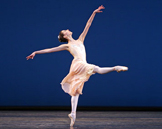 We just stole one of your dancers. Makes a change after all those from Argentina, Australia, Brazil, Bulgaria, Cuba, Denmark, Estonia, France, Georgia, Italy, Japan, Romania, South Africa, Spain, Ukraine etc. whom we recruit. We even have some from Boston and California. But now here comes a native New Yorker, and not just born and bred there: Alexandra Ansanelli has given up a position as principal with New York City Ballet to join the Royal Ballet. Arriving here as a mere first soloist too, but word is that’s only until an expected principal vacancy. Presumably she wanted a different repertoire, so I imagine she must reflect wryly on the unlikely chance that her first two roles here are in works she danced with NYCB.
We just stole one of your dancers. Makes a change after all those from Argentina, Australia, Brazil, Bulgaria, Cuba, Denmark, Estonia, France, Georgia, Italy, Japan, Romania, South Africa, Spain, Ukraine etc. whom we recruit. We even have some from Boston and California. But now here comes a native New Yorker, and not just born and bred there: Alexandra Ansanelli has given up a position as principal with New York City Ballet to join the Royal Ballet. Arriving here as a mere first soloist too, but word is that’s only until an expected principal vacancy. Presumably she wanted a different repertoire, so I imagine she must reflect wryly on the unlikely chance that her first two roles here are in works she danced with NYCB.
read review
Silent Triumph of Tradition
Giselle – Gala evening
The Bolshoi Ballet
Théâtre de la Monnaie
Brussels, Belgium
18-21 February 2006
By Marc Haegeman
copyright 2006 by Marc Haegeman
 The Bolshoi Ballet—or indeed any of the major ballet companies of today—visiting Belgium is by any cultural standard an important if extremely rare event. The renowned Moscow company, led by Alexei Ratmansky, performed with a 74-strong group accompanied by its own orchestra for three consecutive days at the Royal Theatre La Monnaie in Brussels, as the closing part of the prestigious Europalia Festival, an annual multidisciplinary arts happening dedicated this year to Russia. It was in this very same theatre that the Bolshoi performed when it first came to Belgium back in 1958..
The Bolshoi Ballet—or indeed any of the major ballet companies of today—visiting Belgium is by any cultural standard an important if extremely rare event. The renowned Moscow company, led by Alexei Ratmansky, performed with a 74-strong group accompanied by its own orchestra for three consecutive days at the Royal Theatre La Monnaie in Brussels, as the closing part of the prestigious Europalia Festival, an annual multidisciplinary arts happening dedicated this year to Russia. It was in this very same theatre that the Bolshoi performed when it first came to Belgium back in 1958..
read review
A Pension Benefit and a Farewell
Gala for RDB Private Pension Fund
Kirsten Simone retires
Royal Danish Ballet
The Royal Theatre
Copenhagen, Denmark
February 2006
By Eva Kistrup
copyright 2006 by Eva Kistrup
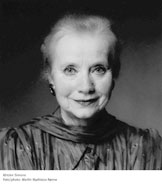 During the last couple of years, Royal Danish Ballet has given a benefit performance for the Private Pension Fund for the dancers. The fund was started by August Bournonville (who else) in 1869 to assist ailing and aging dancers. The Fund is still in existence, even though the dancers now receive a state pension from the age of forty. The Pension Fund Benefits has become a popular venture for dancers and audience, especially as the casts and programmes includes old favourites. This year's programmes included company stalwarts like the Menuet from "Elverhøj," "Coppelia," "Far From Denmark" and a full production of "The Whims of Cupid and The Ballet Masters," the world's oldest ballet still in performance. Neither of these works has been produced by RDB in more than a decade, which is far too long especially for "Whims." Whether "Coppelia" deserves a place on the repertoire is questionable, but at least the gala showed that the ideal lead couple is in place when Thomas Lund and Diana Cuni danced the 3rd act pas de deux.
During the last couple of years, Royal Danish Ballet has given a benefit performance for the Private Pension Fund for the dancers. The fund was started by August Bournonville (who else) in 1869 to assist ailing and aging dancers. The Fund is still in existence, even though the dancers now receive a state pension from the age of forty. The Pension Fund Benefits has become a popular venture for dancers and audience, especially as the casts and programmes includes old favourites. This year's programmes included company stalwarts like the Menuet from "Elverhøj," "Coppelia," "Far From Denmark" and a full production of "The Whims of Cupid and The Ballet Masters," the world's oldest ballet still in performance. Neither of these works has been produced by RDB in more than a decade, which is far too long especially for "Whims." Whether "Coppelia" deserves a place on the repertoire is questionable, but at least the gala showed that the ideal lead couple is in place when Thomas Lund and Diana Cuni danced the 3rd act pas de deux.
read review
Dance In Its Place
"Parsifal"
The Kirov Opera & Orchestra of the Maryinsky Theater
Opera House, The John F. Kennedy Center for the Performing Arts
Washington, DC, USA
February 21, 2006
by George Jackson
copyright ©2006 by George Jackson
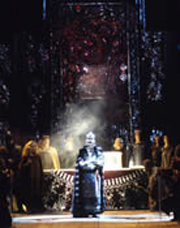 The impression that Richard Wagner was a composer and dramatist insensitive to dance is incorrect. Wagner was too much a man of the theater to ignore something as fundamental as the human body in motion. Two of his operas in repertory, "Rienzi" and "Tannhaüser", include out-and-out ballet divertissements. The 8 other stage works have music meant for less virtuosic dance or for such ceremonial movement as parading and marching. Indications in all 10 works considered "standard Wagner" are that their author also was far from indifferent to the way the singers and supers maneuvered. For him, choreography had its place even if it was of subsidiary importance. Staging these operas is often assigned to choreographers, beginning in Wagner's own lifetime when August Bournonville was charged with the Copenhagen productions. In Paris, it was Lucien Petipa who choreographed the "Les Graces" ballet in "Tannhaüser" that caused a rumpus because it came too early in the evening to suit the late arrivers of the Jockey Club. Diaghilev, in the seasons when he and his Ballets Russes serviced the Monte Carlo Opera's productions, asked George Balanchine to set the dances for "Tannhaüser" and "Meistersinger", which Balanchine did again later for New York's Metropolitan Opera. The list of choreographers from both ballet and modern dance who have worked at Bayreuth's Wagner Festival is staggering. Moreover, Wagner offered to compose an entire ballet for the charming Italian dancer Claudia Cucchi, although that was, perhaps, just gallantry. In all, Wagner may not have written as much ballet music as Verdi, but just compare him to Puccini!
The impression that Richard Wagner was a composer and dramatist insensitive to dance is incorrect. Wagner was too much a man of the theater to ignore something as fundamental as the human body in motion. Two of his operas in repertory, "Rienzi" and "Tannhaüser", include out-and-out ballet divertissements. The 8 other stage works have music meant for less virtuosic dance or for such ceremonial movement as parading and marching. Indications in all 10 works considered "standard Wagner" are that their author also was far from indifferent to the way the singers and supers maneuvered. For him, choreography had its place even if it was of subsidiary importance. Staging these operas is often assigned to choreographers, beginning in Wagner's own lifetime when August Bournonville was charged with the Copenhagen productions. In Paris, it was Lucien Petipa who choreographed the "Les Graces" ballet in "Tannhaüser" that caused a rumpus because it came too early in the evening to suit the late arrivers of the Jockey Club. Diaghilev, in the seasons when he and his Ballets Russes serviced the Monte Carlo Opera's productions, asked George Balanchine to set the dances for "Tannhaüser" and "Meistersinger", which Balanchine did again later for New York's Metropolitan Opera. The list of choreographers from both ballet and modern dance who have worked at Bayreuth's Wagner Festival is staggering. Moreover, Wagner offered to compose an entire ballet for the charming Italian dancer Claudia Cucchi, although that was, perhaps, just gallantry. In all, Wagner may not have written as much ballet music as Verdi, but just compare him to Puccini!
read review
The Winter Season Winds Down at New York City Ballet
“Scenes de Ballet,” “Sonatas and Interludes,” “Tchaikovsky Pas de Deux,” and “Brahms-Schoenberg Quartet”
New York City Ballet
New York State Theater
New York, NY
February 25, 2006 Evening
by Michael Popkin
copyright 2006 by Michael Popkin
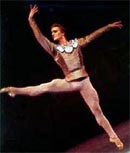 Saturday night New York City Ballet performed “Brahms-Schoenberg Quartet” for the final time this season. “Brahms” is one of Balanchine’s most lyrical works. It is more of a poetic ballet than a formal one, an homage to mid-19th century romanticism. Dreamy and nostalgic in mood and set to the music of Johannes Brahms (though orchestrated by Arnold Schoenberg)—among Balanchine’s works it relates, despite the grandeur of its scale, more to smaller ballets such as “Liebeslieder Waltzes” than it does to works like “Symphony in C,” “Diamonds” or “Theme and Variations,” which are all more in the lineage of the Imperial Russian style. Unfortunately, Saturday night’s performance was, it must be said, substandard.
Saturday night New York City Ballet performed “Brahms-Schoenberg Quartet” for the final time this season. “Brahms” is one of Balanchine’s most lyrical works. It is more of a poetic ballet than a formal one, an homage to mid-19th century romanticism. Dreamy and nostalgic in mood and set to the music of Johannes Brahms (though orchestrated by Arnold Schoenberg)—among Balanchine’s works it relates, despite the grandeur of its scale, more to smaller ballets such as “Liebeslieder Waltzes” than it does to works like “Symphony in C,” “Diamonds” or “Theme and Variations,” which are all more in the lineage of the Imperial Russian style. Unfortunately, Saturday night’s performance was, it must be said, substandard.
read review
Smoothies
Richard Alston Dance Company
The Joyce Theater
New York City
Friday, February 17, 2006
By Nancy Dalva
copyright 2006 by Nancy Dalva
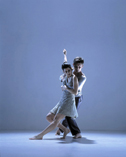 Richard Alston's tasteful and musical choreography arrived in New York on his sleek, personable, technically adept, eponymous troupe, with three pieces all different, yet all alike. The first, "Fever," was to an especially wonderful recording (by the Concerto Italiano, Rinaldo Alessandrini, director)of Monteverdi madrigals and sinfonias. (Like Paul Taylor, he has solved the "recorded music" problem by using an excellent, interesting, idiosyncratic recording.) The second, with Jason Ridgway, in person, limpidly playing Chopin at an on stage piano, was called "Such Longing." The third was to some fabulous tracks from the CD called "Electric Gypsyland." This last number had a curious British-Brazilian flavor. "Sleeping Beauty" meets "Orfeo Negro," sort of.
Richard Alston's tasteful and musical choreography arrived in New York on his sleek, personable, technically adept, eponymous troupe, with three pieces all different, yet all alike. The first, "Fever," was to an especially wonderful recording (by the Concerto Italiano, Rinaldo Alessandrini, director)of Monteverdi madrigals and sinfonias. (Like Paul Taylor, he has solved the "recorded music" problem by using an excellent, interesting, idiosyncratic recording.) The second, with Jason Ridgway, in person, limpidly playing Chopin at an on stage piano, was called "Such Longing." The third was to some fabulous tracks from the CD called "Electric Gypsyland." This last number had a curious British-Brazilian flavor. "Sleeping Beauty" meets "Orfeo Negro," sort of.
read review
Dances For the Brain
2006 Choreographers' Showcase
Clarice Smith Performing Arts Center's Dance Theatre
College Park, MD
February 24-26, 2006
by Kate Mattingly
copyright ©2006 by Kate Mattingly
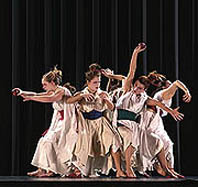 Heady ideas and humanistic movement came together in the 2006 Choreographers‚ Showcase presented by the Clarice Smith Center and the Maryland-National Capital Park and Planning Commission. Fifty-five applicants auditioned for the showcase, now in its 23rd year, and seven pieces were selected by adjudicators Joanna Mendl Shaw and Janis Brenner.
Heady ideas and humanistic movement came together in the 2006 Choreographers‚ Showcase presented by the Clarice Smith Center and the Maryland-National Capital Park and Planning Commission. Fifty-five applicants auditioned for the showcase, now in its 23rd year, and seven pieces were selected by adjudicators Joanna Mendl Shaw and Janis Brenner.
Most of the choreographers on the bill were university instructors, which begged the question: does the academic setting provide the resources in terms of space, salary and bodies that independent choreographers cannot sustain?
read review
Triple Double
New Dances/New Music
Peter Jay Sharp Theater
The Juilliard School
New York, NY
February 25, 2005
By Tom Phillips
copyright 2006 by Tom Phillips
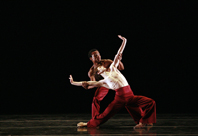 For its 100th birthday, the Juilliard School commissioned a triple double—three new dances, set to three new pieces of music. The all-premiere program was a showcase for the school’s energetic and committed modern dancers, and just as much for its world-class orchestra and the brilliant acoustics of its Peter Jay Sharp Theater. As for the new works themselves, two out of three weren’t bad.
For its 100th birthday, the Juilliard School commissioned a triple double—three new dances, set to three new pieces of music. The all-premiere program was a showcase for the school’s energetic and committed modern dancers, and just as much for its world-class orchestra and the brilliant acoustics of its Peter Jay Sharp Theater. As for the new works themselves, two out of three weren’t bad.
read review
A Vibrant Revival of "Pajama Game"
“Pajama Game”
Directed and choreographed by Kathleen Marshall
Roundabout Theatre Company
American Airlines Theater
New York, NY
February 18, 2006
by Susan Reiter
copyright ©2006 by Susan Reiter
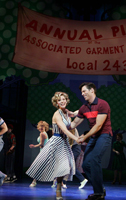 When “The Pajama Game” opened in 1954, it featured a couple of significant firsts. Bob Fosse’s name appeared for the first time as the choreographer of a Broadway show, and Jerome Robbins—although by then a ten-year veteran of Broadway—was credited solely as co-director, marking the first time he was not credited as choreographer. (Various sources mention his “supervising” the newcomer Fosse, and Deborah Jowitt’s biography of Robbins includes his own itemization of his contributions to the show, which included sole responsibility for several major numbers.)
When “The Pajama Game” opened in 1954, it featured a couple of significant firsts. Bob Fosse’s name appeared for the first time as the choreographer of a Broadway show, and Jerome Robbins—although by then a ten-year veteran of Broadway—was credited solely as co-director, marking the first time he was not credited as choreographer. (Various sources mention his “supervising” the newcomer Fosse, and Deborah Jowitt’s biography of Robbins includes his own itemization of his contributions to the show, which included sole responsibility for several major numbers.)
read review
|
|
|